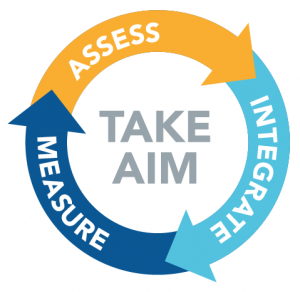Improving Your Member Communications, Part 1
Top recommendations for associations from Association Adviser’s 2015 Communications Benchmarking Report. First up: Learn how to assess your member communications strategy.
Results from the 2015 Association Communication Benchmarking Report suggest that while associations are making great strides in their fight for member engagement, they still struggle with content relevancy, communication integration and using data advantageously to learn more about their members. And while staffing has increased slightly, it does not seem to be increasing sufficiently to handle the ever-increasing communication workload at today’s association. With so many association initiatives tied to communication staff, creating and executing a formal and fully integrated member communications strategy can be a daunting task.
 But it doesn’t have to be if you implement a simple Take AIM (Assess, Integrate, Measure) approach.
But it doesn’t have to be if you implement a simple Take AIM (Assess, Integrate, Measure) approach.
In Part 1 of this article we’ll look closer at how high-performing associations are assessing their member communications. In Part 2, we’ll drill down further into how they’re integrating and measuring.
Social media is fast becoming the preferred way for communicating with members—but one-third of respondents still don’t have a social media strategy in place. ![]()
Subject lines are no different than headlines; you need to grab attention and draw readers to click without being disingenuous. ![]()
Stop underutilizing video, but also don’t underestimate the staying power of print, live events and other legacy media channels. ![]()
To build better content and greater engagement, you must start by asking what members want and why.
Assessment through surveys and face-to-face interaction is a very basic content strategy step, yet it is often overlooked. In an already-cluttered communication space, associations fear they’re asking too much of members and don’t want to add a survey request that requires a decent bit of time and attention.
But with communications strategy in a membership-based organization, how can you give members what they want if you don’t ask? Remember, members live and work in the industry every day and are your best subject matter experts. Administering a survey also involves them in your process, giving them a real sense of association ownership.
Take a closer look at who your stakeholders are and what they are telling you—and what they’re not—to uncover areas for improvement and set your goals.
 Members, staff and advertisers are all stakeholders when it comes to an association’s communications program. An assessment that takes all these audiences into consideration can provide your team with an opportunity to uncover previously unidentified areas for improvement.
Members, staff and advertisers are all stakeholders when it comes to an association’s communications program. An assessment that takes all these audiences into consideration can provide your team with an opportunity to uncover previously unidentified areas for improvement.
Something as simple as looking at your membership demographics can help you make more informed decisions about the best ways to provide information consumption choices. If you were to ask members which competitive publications they read on a regular basis, and the one competitor your staff expected to find is hardly mentioned, then you’ve just uncovered an important factor that will help refine your future strategy.
Associations are communicating more frequently through social media than through any other communication channel, yet roughly one-third of respondents report they are still trying to formulate their social media strategy (32.5 percent).
Particularly with small associations, the question remains: Are we employing a social media program just because? If you don’t have a social media strategy, get one.
![]() Social media gives your association exposure, helps cement your status as an industry thought leader and offers a simple (and free) content integration opportunity. The real beauty of social media is that once an individual makes the basic choice to like your page or follow your feed, you have control. While your members spend personal time on Facebook, you can be in the midst of those family photos and status updates, pushing valuable industry information. It’s worth your while.
Social media gives your association exposure, helps cement your status as an industry thought leader and offers a simple (and free) content integration opportunity. The real beauty of social media is that once an individual makes the basic choice to like your page or follow your feed, you have control. While your members spend personal time on Facebook, you can be in the midst of those family photos and status updates, pushing valuable industry information. It’s worth your while.
Use your survey to learn more about members’ level of social media adoption. Again, stay away from general questions about whether or not they use it; learn why they use it, which channels are most important to them, and build strategy around their preferences.
When it comes to your digital communications, make every message count.
 eNewsletters held their perch again this year as the most highly valued digital communication opportunity. And, while associations feel they are making progress in combating information overload, this challenge has remained the single most frequently cited communication challenge since we began our annual study in 2011. It’s imperative that you have a plan and avoid a fire drill approach when it comes to your eNewsletter and email communications.
eNewsletters held their perch again this year as the most highly valued digital communication opportunity. And, while associations feel they are making progress in combating information overload, this challenge has remained the single most frequently cited communication challenge since we began our annual study in 2011. It’s imperative that you have a plan and avoid a fire drill approach when it comes to your eNewsletter and email communications.
Subject lines are no different than headlines; you need to grab attention and draw readers to click. Once they click, what will they find? Is the design attractive? Are the sources reputable? Are there content takeaways? How often do you include photos, graphics and video? Ask members what they think about the content.
Assessment also gives you an opportunity to learn more about segmentation opportunities. Ask members if they opt out of communication because information is too broad. What do they consider to be a just-right frequency? If you send several sector-specific eNewsletters, would the general membership want to see everything in a weekly digest?
Stop under-utilitizing video. Yesterday.

According to Forrester Research, 74 percent of all Internet traffic will be video by 2017. While our own research found that only one-third of associations (37.9 percent) consider video part of their overall content strategy, continuing education, event memorialization, live streaming and integration opportunities make video an incredibly viable communication tool. Sponsorship and advertising opportunities also fit well into this vehicle, providing your trusted vendors an opportunity to have considerable branding time in front of members.
Focus your AIM
If nothing else, avoid “shiny-object syndrome” and the temptation to be all things to all people. Consider how relatively simple a communications strategy can be with a Take AIM approach. Gather member feedback, deliver great content, monitor results, and watch engagement levels rise. Again, I’ll discuss integration and measurement in Part 2.


